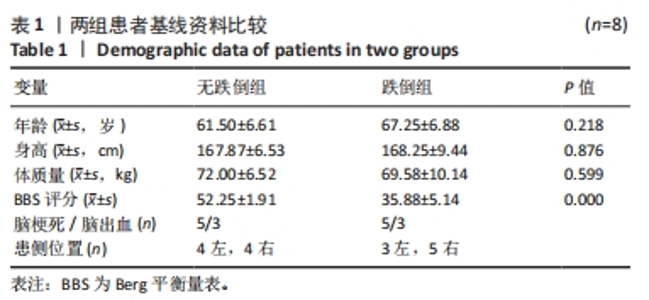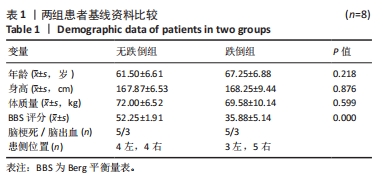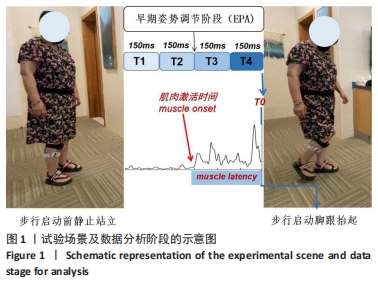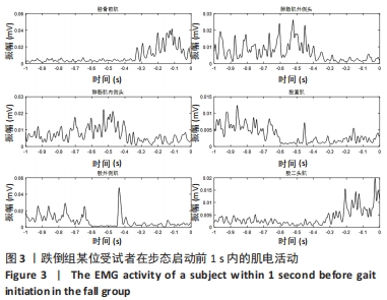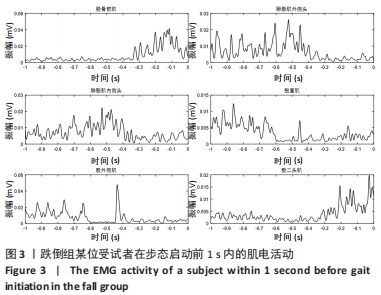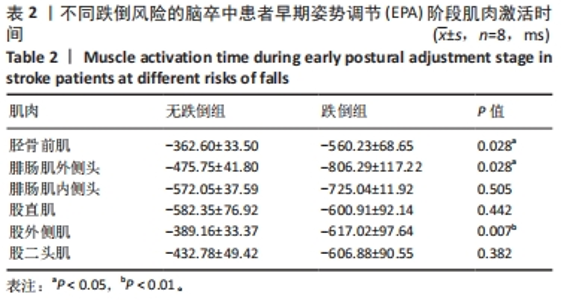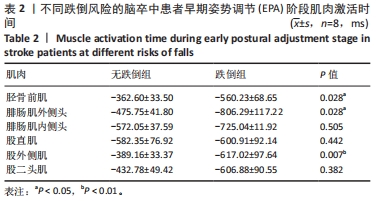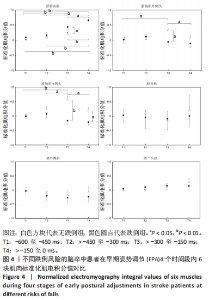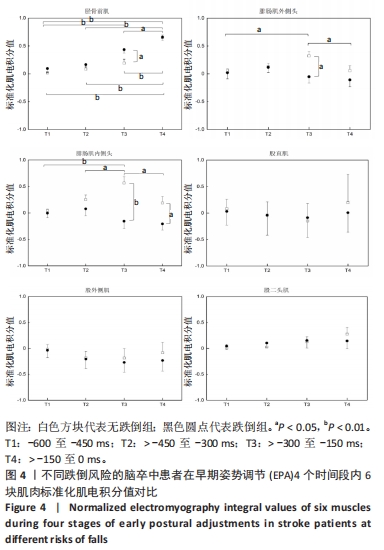Chinese Journal of Tissue Engineering Research ›› 2024, Vol. 28 ›› Issue (28): 4429-4435.doi: 10.12307/2024.494
Characterization of temporal and intensity parameters of early postural adjustment phase during gait initiation in stroke patients
Zhao Zhuoyue1, Liu Jiawen2, Sun Changcheng1, Zhang Gaoshuai1, Zhang Ying1, Xu Rui2
- 1Tianjin People’s Hospital, Tianjin 300122, China; 2Tianjin University, Tianjin 300072, China
-
Received:2023-08-22Accepted:2023-09-25Online:2024-10-08Published:2023-11-25 -
Contact:Zhang Ying, Master, Chief physician, Tianjin People’s Hospital, Tianjin 300122, China Xu Rui, PhD, Associate professor, Tianjin University, Tianjin 300072, China -
About author:Zhao Zhuoyue, Master, Therapist-in-charge, Tianjin People’s Hospital, Tianjin 300122, China -
Supported by:National Natural Science Foundation of China (General Program), No. 82272115 (to XR); Key Program of Tianjin People’s Hospital, No. 2022YJZD004 (to ZZY)
CLC Number:
Cite this article
Zhao Zhuoyue, Liu Jiawen, Sun Changcheng, Zhang Gaoshuai, Zhang Ying, Xu Rui. Characterization of temporal and intensity parameters of early postural adjustment phase during gait initiation in stroke patients[J]. Chinese Journal of Tissue Engineering Research, 2024, 28(28): 4429-4435.
share this article
Add to citation manager EndNote|Reference Manager|ProCite|BibTeX|RefWorks
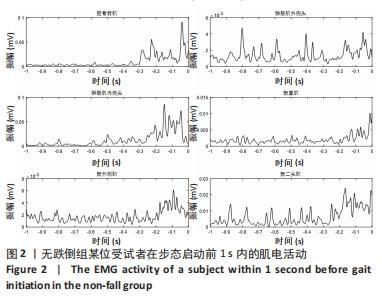
2.4 不同跌倒风险的脑卒中患者下肢关键肌EPA启动时间的特点 图2是无跌倒组某位受试者迈步前1 s内的肌电活动,图3为跌倒组某位受试者迈步前1 s内的肌电活动。通过图2,3和表2可以看出2组患者6块肌肉均在t0点前激活,说明2组受试者均在预备状态自然向前迈步时产生了前馈姿势控制,无跌倒组在EPA阶段依次激活的是股直肌、腓肠肌内侧头、腓肠肌外侧头、股二头肌、股外侧肌、胫骨前肌,该组患者下肢伸肌的激活时间早于下肢屈肌的激活时间。跌倒组在EPA阶段依次激活的是腓肠肌外侧头、腓肠肌内侧头、股外侧肌、股直肌、股二头肌、胫骨前肌。跌倒组患者下肢肌肉的激活顺序与无跌倒组不同,2组对照从顺序上观察值得注意的是:无跌倒组股直肌激活在第1位,而跌倒组股直肌激活在第4位;无跌倒组股外侧肌激活在第6位,而跌倒组股外侧肌激活在第3位。从单块肌肉激活时间2组间对比,跌倒组其他6块肌肉在EPA阶段激活时间都早于无跌倒组;其中跌倒组EPA阶段胫骨前肌、腓肠肌外侧头和股外侧肌的激活时间显著早于无跌倒组(P < 0.01,P < 0.05)。其他肌肉的激活时间差异无显著性意义(P > 0.05)。"
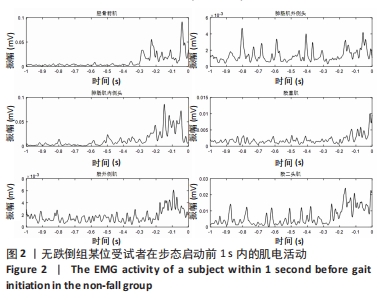
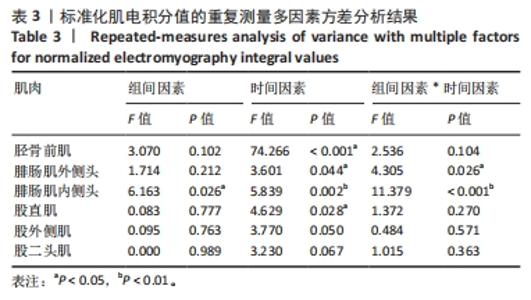
2.5 不同跌倒风险的脑卒中患者下肢关键肌EPAs强度的特点 表3显示了2组受试者的6块肌肉在EPA阶段的4个时间窗内标准化肌电积分值的组间差异、时间差异和组间组内因素的交互作用。6块肌肉中腓肠肌内侧头的标准化肌电积分值在组间因素上表现出了显著性差异(P < 0.05);胫骨前肌、腓肠肌外侧头、腓肠肌内侧头和股直肌的标准化肌电积分值在时间因素上表现出了显著性差异(P < 0.01,P < 0.05);在不同试验组和不同时间段内之间腓肠肌外侧头和腓肠肌内侧头的标准化肌电积分值表现出高度的交互作用(P < 0.01,P < 0.05)。根据以上结果,小腿部的3块肌肉(胫骨前肌、腓肠肌外侧头、腓肠肌内侧头)的标准化肌电积分值在不同试验组下或时间段内都存在显著性差异(P < 0.01,P < 0.05),大腿部的3块肌肉只有股直肌的标准化肌电积分值在时间因素上表现出了显著性差异(P < 0.05)。为了更加深入了解2组受试者下肢EPA阶段肌电活动随着时间变化的特点,继续对16名受试者每块肌肉的肌电积分值在不同时间段及不同试验组下的均值结果进行单因素方差分析。"
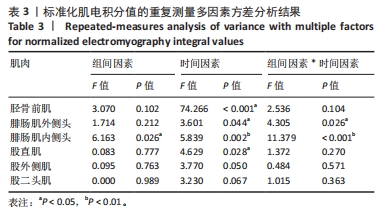
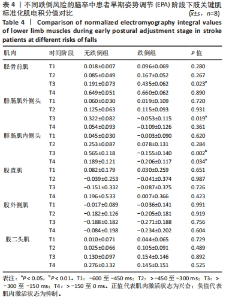
当标准化肌电积分值在时间窗内值为正值时,代表肌肉激活状态为兴奋;当标准化肌电积分值在时间窗内值为负值时,代表肌肉激活状态为抑制。 表4是2组患者6块肌肉在4个时间窗内标准化肌电积分值的均值和标准误差。图4标出了2组患者在EPA阶段4个时间窗内下肢关键肌的标准化肌电积分值组内时间因素和组间分组因素的对比结果。从组间对比上观察,无跌倒组和跌倒组在EPA阶段胫骨前肌都表现出了兴奋的激活特点,跌倒组在EPA的4个时间窗内胫骨前肌的活动强度都高于无跌倒组,在迈步前> -300至-150 ms的时间段胫骨前肌的肌电活动显著高于无跌倒组(P < 0.05);而跌倒组的腓肠肌外侧头和腓肠肌内侧头在迈步前> -300至-0 ms时间段内表现出了抑制的激活特点,但无跌倒组的腓肠肌外侧头和腓肠肌内侧头在迈步前> -300至-0 ms时间段内表现出了兴奋的激活特点,与无跌倒组相比跌倒组的腓肠肌外侧头在T3阶段表现出了显著的抑制性激活(P < 0.05),同时,跌倒组的腓肠肌内侧头也在T3和T4阶段表现出了显著的抑制性激活(P < 0.01,P < 0.05)。值得指出的是,2组受试者大腿部的3块关键肌在EPA的4个时间窗内的标准化肌电积分值均没有表现出显著性差异(P > 0.05),但无跌倒组3块大腿部肌肉的在T4阶段标准化肌电积分值的均值都大于跌倒组。"
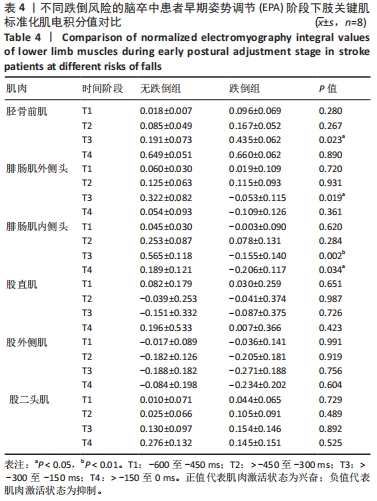

从组内的时间因素观察,无跌倒组胫骨前肌在T4阶段的肌电活动显著高于T1、T2、T3阶段(P < 0.01),而跌倒组胫骨前肌除了在T4阶段的肌电活动显著高于T1、T2、T3阶段(P < 0.01,P < 0.05),T3阶段的肌电活动也显著高于T1阶段(P < 0.01,见图4A)。无跌倒组腓肠肌外侧头在T3阶段表现出了显著的兴奋性激活的特点,T3阶段肌电活动显著高于T1和T4阶段(P < 0.05),而跌倒组腓肠肌外侧头在T3阶段表现出了抑制性激活的特点,并且在T3阶段同无跌倒组有显著性差异(P < 0.05,见图4B)。无跌倒组腓肠肌内侧头在T3阶段表现出了显著的兴奋性激活的特点,T3阶段肌电活动显著高于T1、T2和T4阶段(P < 0.01,P < 0.05),而跌倒组腓肠肌外侧头在T3、T4阶段表现出了抑制性激活的特点,并且在T3、T4阶段同无跌倒组有显著性差异(P < 0.01,P < 0.05,见图4C)。而2组患者大腿部的3块肌肉均未在4个时间窗内表现出显著差异(P > 0.05)。"

| [1] 王陇德,彭斌,张鸿祺,等.《中国脑卒中防治报告2020》概要[J].中国脑血管病杂志,2022,19(2):136-144. [2] 江滨.现阶段我国脑卒中流行特征及防治现状对全科医疗服务的启示和建议[J].中国全科医学,2019,22(30):3653-3661. [3] Goto Y, Otaka Y, Suzuki K, et al. Incidence and circumstances of falls among community-dwelling ambulatory stroke survivors: a prospective study. Geriatr Gerontol Int. 2019;19(3):240-244. [4] Tsai W, Lien H, Liu W, et al. Early and anticipatory postural adjustments in healthy subjects under stable and unstable sitting conditions. J Electromyogr Kinesiol. 2018;12(43):21-27. [5] Belenkiy V, Gurfinkel V, Pal’tsev Y. Elements of control of voluntary movements. Biofizika. 1967;12(1):135-141. [6] Kanekar N, Aruin AS. Improvement of anticipatory postural adjustments for balance control:effect of a single training session. J Electromyogr Kinesiol. 2015;25(2):400-405. [7] Krishnan V, Aruin AS, Latash ML. Two stages and three components of the postural preparation to action. Exp Brain Res. 2011;212(1):47-63. [8] Klous M, Mikulic P, Latash ML. Early postural adjustments in preparation to whole-body voluntary sway. J Electromyogr Kinesiol. 2012;22(1):110-116. [9] 中华医学会神经病学分会,中华医学会神经病学分会脑血管病学组.中国各类主要脑血管病诊断要点2019[J]. 中华神经科杂志,2019,52(9):710-715. [10] Harm S, Latash ML. The effects of muscle vibration on anticipatory postural adjustments. Brain Res. 2004;1015(1-2):57-72. [11] CESARI P, PISCITELLI F, PASCUCCI F, et al. Postural Threat Influences the Coupling Between Anticipatory and Compensatory Postural Adjustments in Response to an External Perturbation. Neuroscience. 2022;10(490):25-35. [12] Asaka T, Wang Y, Fukushima J, et al. Learning effects on muscle modes and multi-mode postural synergies. Exp Brain Res. 2008;184(3):323-338. [13] Danna-Dos-Santos A, Slomka K, Zatsiorsky VM, et al. Muscle modes and synergies during voluntary body sway. Exp Brain Res. 2007;179(4):533-550. [14] Zhao Z, Watanabe K, Asaka T, et al. Postural control in preparation to a step during support surface perturbation. Res Sports Med. 2020;28(4):588-593. [15] Curuk E, lEE y, Aruin AS. Individuals With Stroke Use Asymmetrical Anticipatory Postural Adjustments When Counteracting External Perturbations. Motor Control. 2019;1-11. doi: 10.1123/mc.2018-0083. [16] Wang Y, Watanabe K, Asaka T. Anticipatory and Compensatory Postural Adjustments in Response to Dynamic Platform Perturbation during a Forward Step. J Mot Behav. 2023;55(1):31-38. [17] Brunt D, Vander Linden DW, Behrman AL. The Relation between limb loading and control parameters of gait initiation in persons with stroke. Arch Phys Med Rehabil. 1995;76(7):627-634. [18] Sousa A, Silva A, Santos R. Ankle anticipatory postural adjustments during gait initiation in healthy and post-stroke subjects. Clin Biomech (Bristol, Avon). 2015;30(9):960-965. [19] Kirker SG, Simpson DS, Jenner JR,et al. Stepping before standing hip muscle function in stepping and standing balance after stroke. J Neurol Neurosurg Psychiatry. 2000;68(4):458-464. [20] Ko M, Bishop MD, Behrman AL. Effects of limb loading on gait initiation in persons with moderate hemiparesis. Top Stroke Rehabil. 2011;18(3):258-268. [21] RAjachandrakumar R, Fraser JE, Schinkel-Ivy A, et al. Atypical anticipatory postural adjustments during gait initiation among individuals with sub- acute stroke. Gait Posture. 2017;52:325-331. [22] Curuk E,Lee Y, Aruin AS. Individuals with stroke improve anticipatory postural adjustments after a single session of targeted exercises. Hum Mov Sci. 2020;69:102559. [23] McCombe Waller S, Yang CL, Magder L, et al. Impaired motor preparation and execution during standing reach in peoplewith chronic stroke. Neurosci Lett. 2016;630:38-44. [24] Pollock CL, Carpenter MG, Hunt MA, et al. Physiological arousal accompanying postural responses to external perturbations after stroke. Clin Neurophysiol. 2017;128(6):935-944. [25] Bouisset S, DO M. Posture, dynamic stability, and voluntary movement. Neurophysiol Clin. 2008;38(6):345-362. [26] Wang D, Mahe G, Vidal PP. Inconsistent anticipatory postural adjustments (APAs) in rugby players: a source of injuries? BMJ Open Sport Exerc Med. 2018; 4(1):e000303. [27] Ito T, Azuma T, Yamashita N. Anticipatory control in the initiation of a single step under biomechanical constraints in humans. Neurosci Lett. 2003;352(3):207-210. [28] Frank JS, Earl M. Coordination of posture and movement. Physical Therapy. 1990;70(12):855-863. [29] Fiolkowski P, Brunt D, Bishop M, et al. Does postural instability affect the initiation of human gait?.Neurosci Lett. 2002;323(3):167-170. [30] Queralt A, Valls-Solé J, Castellote JM. Speeding up gait initiation and gait-pattern with a startling stimulus. Gait Posture. 2010;31(2):185-190. [31] Kaoru Takakusaki. Neurophysiology of gait:from the spinal cord to the frontal lobe.Mov Disord. 2013;28(11):1483-1491. |
| [1] | Zhang Ming, Wang Bin, Jia Fan, Chen Jie, Tang Wei. Application of brain-computer interface technology based on electroencephalogram in upper limb motor function rehabilitation of stroke patients [J]. Chinese Journal of Tissue Engineering Research, 2024, 28(4): 581-586. |
| [2] | Guan Jinqi, Sun Pingping, Bian Jing, Yan Xue, Zhang Weimin. Gastrodin intervention attenuates inflammatory injury in ischemic stroke rats [J]. Chinese Journal of Tissue Engineering Research, 2024, 28(28): 4535-4540. |
| [3] | Duan Yanzhe, Hua Jianlin, Ding Zhibin, Jiang Nan, Song Lijuan, Yan Yuqing, Ma Cungen. Visual analysis of the effect of apoptosis on ischemic stroke [J]. Chinese Journal of Tissue Engineering Research, 2024, 28(26): 4145-4150. |
| [4] | Xia Tianqing, Rong Mengwei, Dan Cunyan, Yang Ting, Ding Zhibin, Song Lijuan, Ma Cungen. Frontier hot trends in ischemic stroke and vascular regeneration based on bibliometric analysis [J]. Chinese Journal of Tissue Engineering Research, 2024, 28(23): 3692-3698. |
| [5] | Wan Jun, Bai Yanjie, Wang Yan, Chen Shuying, Chen Limin, Xiao Yuqian, Sun Kexin. Mechanism of action and related signaling pathways of long non-coding RNAs in neuroimmuno-inflammatory response after ischemic stroke [J]. Chinese Journal of Tissue Engineering Research, 2024, 28(20): 3265-3271. |
| [6] | Chang Wanpeng, Zhang Zhongwen, Yang Yulin, Zi Yang, Yang Mengqi, Du Bingyu, Wang Nan, Yu Shaohong. Efficacy of rehabilitation exoskeleton robots on post-stroke lower limb motor dysfunction: a Meta-analysis [J]. Chinese Journal of Tissue Engineering Research, 2024, 28(2): 321-328. |
| [7] | Chen Na, Wang Yanlin, Sun Huifang, Fan Feiyan, Li Donghong, Zhang Yunke. Shexiang Huangqi compound dripping pills-containing serum promotes proliferation and differentiation of bone marrow mesenchymal stem cells [J]. Chinese Journal of Tissue Engineering Research, 2024, 28(19): 2960-2966. |
| [8] | Li Yanjie, Li Sijin, Hua Xiaoqiong, Qin Hewei, Jin Xiaoqin, Zhang Zhixin. Effects of Lipopharyngeal Qibi Formula on swallowing function and apoptosis in central cortical swallowing neurons in rats after stroke [J]. Chinese Journal of Tissue Engineering Research, 2024, 28(16): 2527-2533. |
| [9] | Xu Kangli, An Lanhua, Zhang Jinsheng, Du Xiaoyan, Yin Lele, Zhang Xixian. Research hotspots and frontiers of functional magnetic resonance imaging in treatment of ischemic stroke by traditional Chinese medicine [J]. Chinese Journal of Tissue Engineering Research, 2024, 28(11): 1789-1796. |
| [10] | Ying Chunmiao, Pan Xiaolong, Liu Feixiang, Chen Na, Fan Feiyan, Zhang Yunke. Effect of traditional Chinese medicine and compounds for supplementing qi and activating blood circulation and inducing resuscitation on regulating stem cells to promote nerve repair of acute ischemic stroke [J]. Chinese Journal of Tissue Engineering Research, 2024, 28(1): 121-130. |
| [11] | Yang Ting, Ding Zhibin, Jiang Nan, Han Hongxia, Hou Miaomiao, Ma Cungen, Song Lijuan, Li Xinyi. Astrocytes regulate glial scar formation in cerebral ischemic stroke [J]. Chinese Journal of Tissue Engineering Research, 2024, 28(1): 131-138. |
| [12] | Yu Wenqiang, Ren Fuchao, Shi Guohong, Xu Yuanjing, Liu Tongyou, Xie Youzhuan, Wang Jinwu, . Methods and application of gait analysis of lower limbs after stroke [J]. Chinese Journal of Tissue Engineering Research, 2023, 27(8): 1257-1263. |
| [13] | Nie Chenchen, Su Kaiqi, Gao Jing, Fan Yongfu, Ruan Xiaodi, Yuan Jie, Duan Zhaoyuan, Feng Xiaodong. The regulatory role of circular RNAs in cerebral ischemia-reperfusion injury [J]. Chinese Journal of Tissue Engineering Research, 2023, 27(8): 1286-1291. |
| [14] | Liu Shiwen, Liu Quanfeng, Yang Zhibo, Duan Changqiu, Zhang Baoying, Tan Yue, Ai Changshan, Jiang Huiqiang, Feng Xugang, Kong Nianhua. Rhythmic auditory stimulation for non-acute dyskinesia in stroke patients [J]. Chinese Journal of Tissue Engineering Research, 2023, 27(35): 5583-5588. |
| [15] | Wang Shaona, Liu Feixiang, Ying Chunmiao, Gao Chen, Zhang Yunke. Action mechanism of traditional Chinese medicine combined with bone marrow mesenchymal stem cells in regulating blood-brain barrier after cerebral ischemia reperfusion injury [J]. Chinese Journal of Tissue Engineering Research, 2023, 27(33): 5377-5384. |
| Viewed | ||||||
|
Full text |
|
|||||
|
Abstract |
|
|||||
